2007 SUBARU FORESTER battery
[x] Cancel search: batteryPage 35 of 356
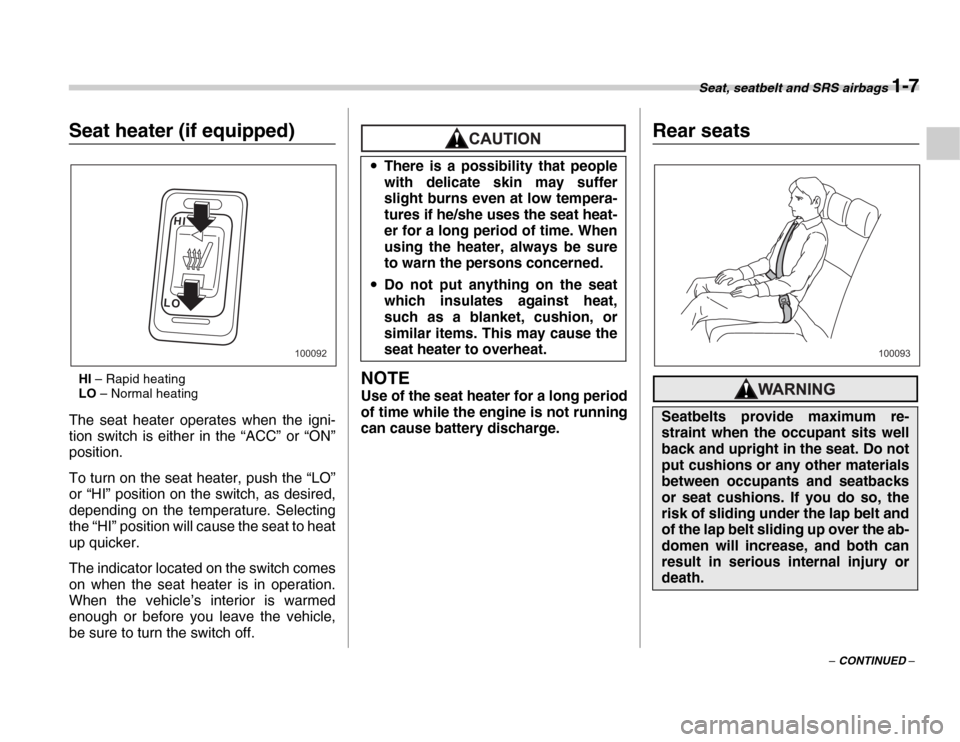
Seat, seatbelt and SRS airbags 1-7
– CONTINUED –
Seat heater (if equipped)HI – Rapid heating
LO – Normal heating
The seat heater operates when the igni-
tion switch is either in the “ACC” or “ON”
position.
To turn on the seat heater, push the “LO”
or “HI” position on the switch, as desired,
depending on the temperature. Selecting
the “HI” position will cause the seat to heat
up quicker.
The indicator located on the switch comes
on when the seat heater is in operation.
When the vehicle’s interior is warmed
enough or before you leave the vehicle,
be sure to turn the switch off.
NOTE
Use of the seat heater for a long period
of time while the engine is not running
can cause battery discharge.
Rear seats
HI
LO
100092
�y There is a possibility that people
with delicate skin may suffer
slight burns even at low tempera-
tures if he/she uses the seat heat-
er for a long period of time. When
using the heater, always be sure
to warn the persons concerned.
�y Do not put anything on the seat
which insulates against heat,
such as a blanket, cushion, or
similar items. This may cause the
seat heater to overheat.
Seatbelts provide maximum re-
straint when the occupant sits well
back and upright in the seat. Do not
put cushions or any other materials
between occupants and seatbacks
or seat cushions. If you do so, the
risk of sliding under the lap belt and
of the lap belt sliding up over the ab-
domen will increase, and both can
result in serious internal injury or
death.
100093
Page 47 of 356
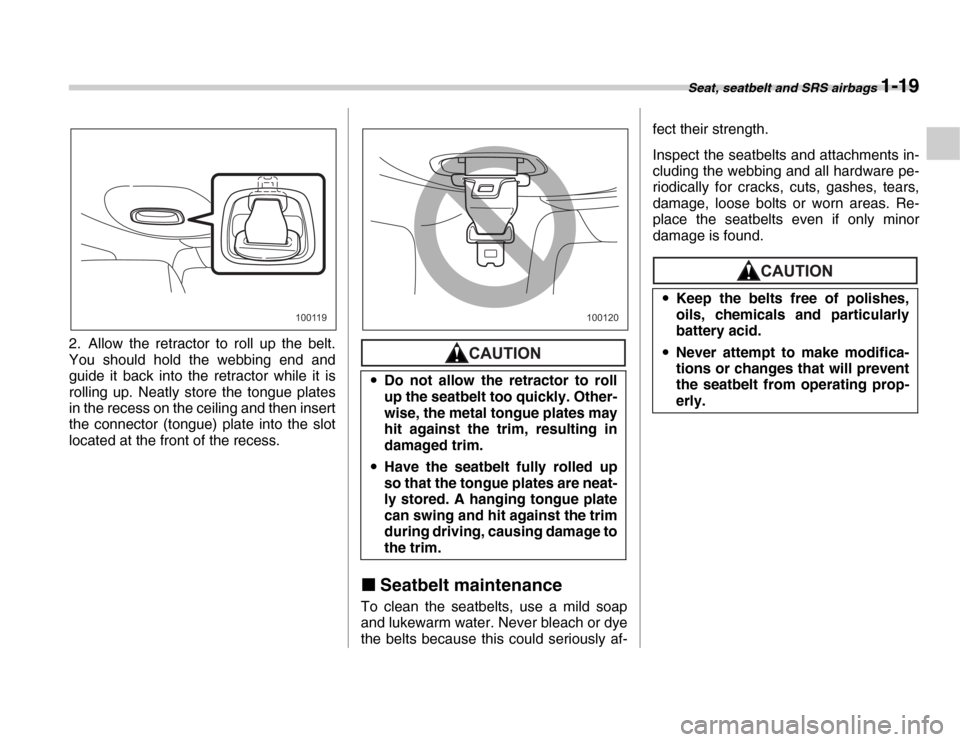
Seat, seatbelt and SRS airbags 1-19
2. Allow the retractor to roll up the belt.
You should hold the webbing end and
guide it back into the retractor while it is
rolling up. Neatly store the tongue plates
in the recess on the ceiling and then insert
the connector (tongue) plate into the slot
located at the front of the recess.
�„Seatbelt maintenance
To clean the seatbelts, use a mild soap
and lukewarm water. Never bleach or dye
the belts because this could seriously af- fect their strength.
Inspect the seatbelts and attachments in-
cluding the webbing and all hardware pe-
riodically for cracks, cuts, gashes, tears,
damage, loose bolts or worn areas. Re-
place the seatbelts even if only minor
damage is found.
100119
�y
Do not allow the retractor to roll
up the seatbelt too quickly. Other-
wise, the metal tongue plates may
hit against the trim, resulting in
damaged trim.
�y Have the seatbelt fully rolled up
so that the tongue plates are neat-
ly stored. A hanging tongue plate
can swing and hit against the trim
during driving, causing damage to
the trim.
100120
�yKeep the belts free of polishes,
oils, chemicals and particularly
battery acid.
�y Never attempt to make modifica-
tions or changes that will prevent
the seatbelt from operating prop-
erly.
Page 89 of 356

2
Keys and doors
Keys ..................................................................... 2-2Key number ............................................................. 2-2
Immobilizer (if equipped) ................................... 2-3 Security ID plate ..................................................... 2-3
Security indicator light ....................................... 2-3
Key replacement ..................................................... 2-4
Door locks ........................................................... 2-4 Locking and unlocking from the outside ............. 2-4
Locking and unlocking from the inside ................ 2-5
Power door locking switches ............................ 2-6 Key lock-in prevention function ............................ 2-6
Remote keyless entry system ........................... 2-6 Locking the doors .................................................. 2-7
Unlocking the doors ............................................... 2-7
Illuminated entry ..................................................... 2-8
Vehicle finder function ........................................... 2-8
Sounding a panic alarm ......................................... 2-8
Selecting audible signal operation ....................... 2-8
Replacing the battery ............................................. 2-8
Replacing lost transmitters ................................... 2-9
Alarm system ...................................................... 2-12 System operation ................................................... 2-12
Activating and deactivating the alarm system ..... 2-13
If you have accidentally triggered the alarm system ................................................................... 2-13
Arming the system ................................................. 2-13
Disarming the system ............................................ 2-14
Valet mode .............................................................. 2-15
Passive arming ....................................................... 2-15 Tripped sensor identification ................................ 2-16
Shock sensors (dealer option) .............................. 2-16
Child safety locks ............................................... 2-17
Windows .............................................................. 2-18 Power windows ....................................................... 2-18
Rear gate ............................................................. 2-20
Moonroof (if equipped) ...................................... 2-21 To open the moonroof ............................................ 2-21
To close the moonroof ........................................... 2-21
Anti-entrapment function ....................................... 2-21
Page 96 of 356
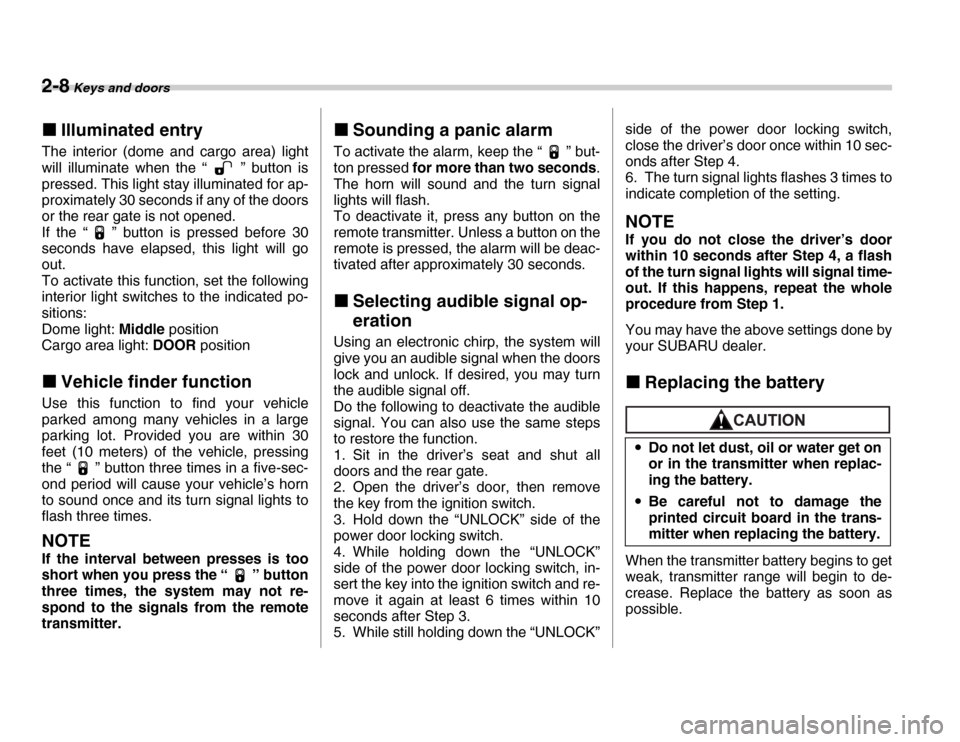
2-8 Keys and doors
�„Illuminated entry
The interior (dome and cargo area) light
will illuminate when the “ ” button is
pressed. This light stay illuminated for ap-
proximately 30 seconds if any of the doors
or the rear gate is not opened.
If the “ ” button is pressed before 30
seconds have elapsed, this light will go
out.
To activate this function, set the following
interior light switches to the indicated po-
sitions:
Dome light: Middle position
Cargo area light: DOOR position
�„ Vehicle finder function
Use this function to find your vehicle
parked among many vehicles in a large
parking lot. Provided you are within 30
feet (10 meters) of the vehicle, pressing
the “ ” button three times in a five-sec-
ond period will cause your vehicle’s horn
to sound once and its turn signal lights to
flash three times.
NOTE
If the interval between presses is too
short when you press the “ ” button
three times, the system may not re-
spond to the signals from the remote
transmitter. �„
Sounding a panic alarm
To activate the alarm, keep the “ ” but-
ton pressed for more than two seconds .
The horn will sound and the turn signal
lights will flash.
To deactivate it, press any button on the
remote transmitter. Unless a button on the
remote is pressed, the alarm will be deac-
tivated after approximately 30 seconds. �„ Selecting audible signal op-
eration
Using an electronic chirp, the system will
give you an audible signal when the doors
lock and unlock. If desired, you may turn
the audible signal off.
Do the following to deactivate the audible
signal. You can also use the same steps
to restore the function.
1. Sit in the driver’s seat and shut all
doors and the rear gate.
2. Open the driver’s door, then remove
the key from the ignition switch.
3. Hold down the “UNLOCK” side of the
power door locking switch.
4. While holding down the “UNLOCK”
side of the power door locking switch, in-
sert the key into the ignition switch and re-
move it again at least 6 times within 10
seconds after Step 3.
5. While still holding down the “UNLOCK” side of the power door locking switch,
close the driver’s door once within 10 sec-
onds after Step 4.
6. The turn signal lights flashes 3 times to
indicate completion of the setting.
NOTE
If you do not close the driver’s door
within 10 seconds after Step 4, a flash
of the turn signal lights will signal time-
out. If this happens, repeat the whole
procedure from Step 1.
You may have the above settings done by
your SUBARU dealer. �„ Replacing the battery
When the transmitter battery begins to get
weak, transmitter range will begin to de-
crease. Replace the battery as soon as
possible.
�yDo not let dust, oil or water get on
or in the transmitter when replac-
ing the battery.
�y Be careful not to damage the
printed circuit board in the trans-
mitter when replacing the battery.
Page 97 of 356
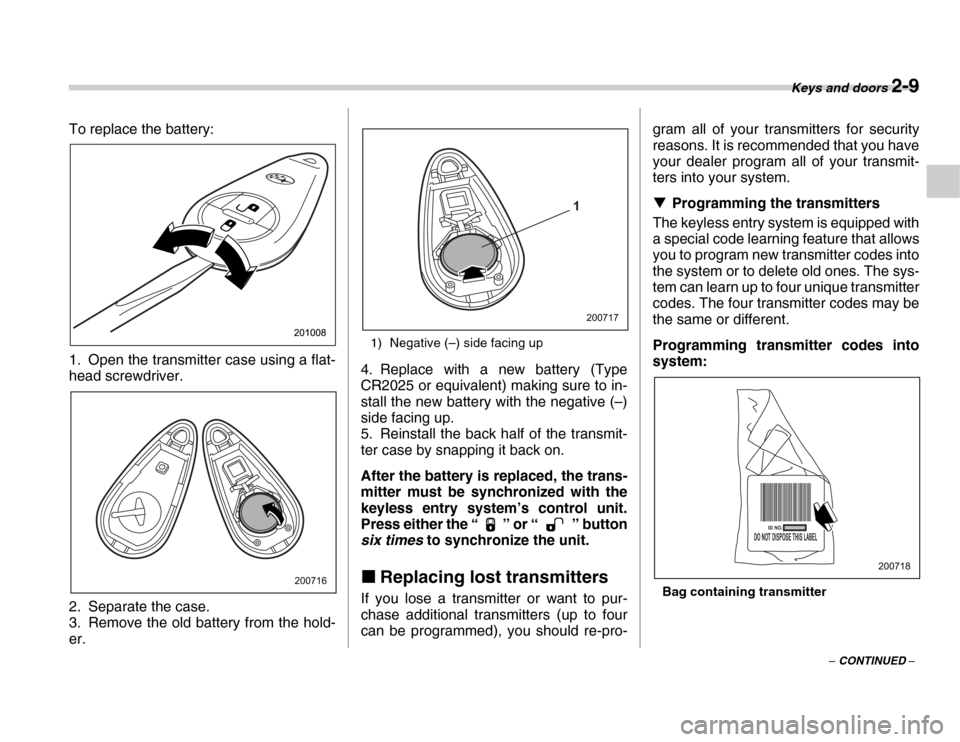
Keys and doors 2-9
– CONTINUED –
To replace the battery:
0
1. Open the transmitter case using a flat-
head screwdriver.
2. Separate the case.
3. Remove the old battery from the hold- er.
1) Negative (–) side facing up
4. Replace with a new battery (Type
CR2025 or equivalent) making sure to in-
stall the new battery with the negative (–)
side facing up.
5. Reinstall the back half of the transmit-
ter case by snapping it back on.
After the battery is replaced, the trans-
mitter must be synchronized with the
keyless entry system’s control unit.
Press either the “ ” or “ ” button
six times to synchronize the unit.
�„ Replacing lost transmitters
If you lose a transmitter or want to pur-
chase additional transmitters (up to four
can be programmed), you should re-pro- gram all of your transmitters for security
reasons. It is recommended that you have
your dealer program all of your transmit-
ters into your system. �T
Programming the transmitters
The keyless entry system is equipped with
a special code learning feature that allows
you to program new transmitter codes into
the system or to delete old ones. The sys-
tem can learn up to four unique transmitter
codes. The four transmitter codes may be
the same or different.
Programming transmitter codes into
system:
Bag containing transmitter
200716
1
200717
200718
Page 103 of 356

Keys and doors 2-15
– CONTINUED –
NOTE (Models with immobiliz-
er)
If your vehicle is equipped with an im-
mobilizer, the immobilizer’s function
will cause the security indicator light to
flash (approximately once every three
seconds) even after the system is dis-
armed.
NOTE
The system can be disarmed by the fol-
lowing method, too. �y Cycle the ignition switch from the
“LOCK” to the “ON” position three
times within 5 seconds. �T Emergency disarming
If you cannot disarm the system using the
transmitter (i.e. the transmitter is lost, bro-
ken or the transmitter battery is too weak),
you can disarm the system without using
the transmitter.
1. Unlock the door with the key and then
open the door.
2. Insert the key into the ignition switch
and cycle it from the “LOCK” to the “ON”
position three times within 5 seconds.
�„ Valet mode
When you choose the valet mode, the se-
curity system does not operate. In valet
mode, the remote transmitter is used only for locking and unlocking the doors and
rear gate and panic activation.
To enter the valet mode, change the set-
ting of your vehicle’s alarm system for de-
activation mode. (Refer to “Activating and
deactivating the alarm system” in this sec-
tion.) The security indicator light will con-
tinue to flash once every three seconds in-
dicating that the system is in the valet
mode (only vehicle with an immobilizer).
To exit valet mode, change the setting of
your vehicle’s alarm system for activation
mode. (Refer to “Activating and deactivat-
ing the alarm system” in this section.)
NOTE
If your vehicle is not equipped with an
immobilizer, the security indicator light
does not flash during the valet mode. �„
Passive arming
When passive arming mode has been
programmed by the dealer, arming of the
system is automatically accomplished
without using the remote transmitter. Note
that in this mode, DOORS MUST BE
MANUALLY LOCKED. �T To enter the passive mode
If you wish to program the passive arming
mode, have it done by your SUBARU dealer. �T
Arming the system1. Turn the ignition switch to the “ON” po-
sition.
1) ON
2) LOCK
In passive mode, the system will au-
tomatically activate the alarm but
WILL NOT automatically lock the
doors. In order to lock the doors you
must either lock them as indicated
in the following step 4 or with the
key once they have been closed.
Failure to lock the doors manually
will result in a higher security risk.
1
2
200816
Page 108 of 356
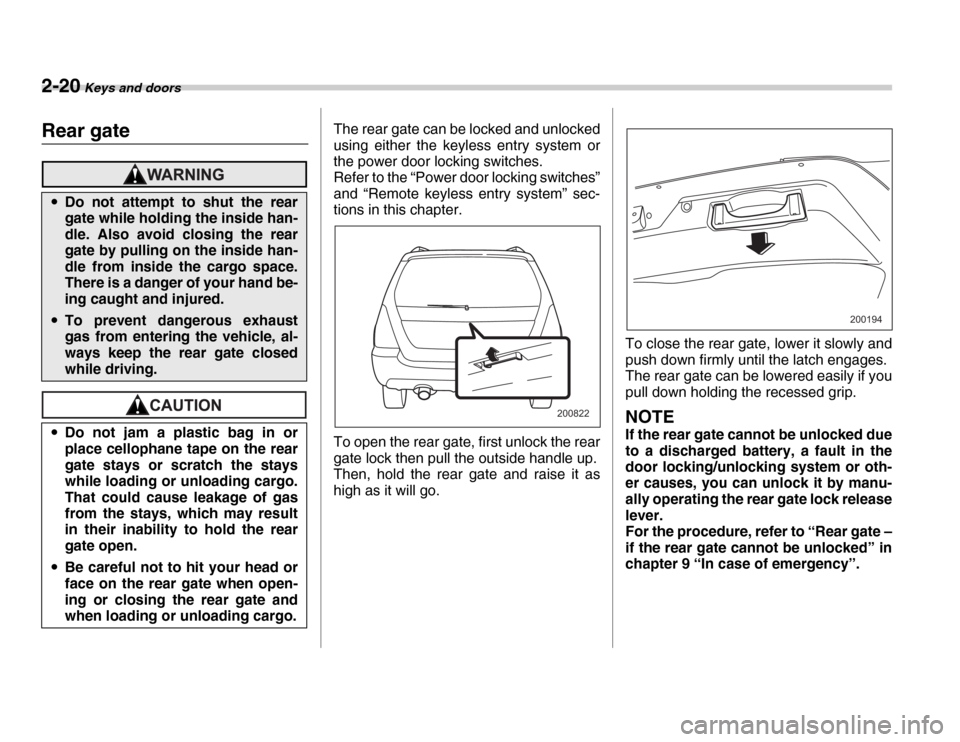
2-20 Keys and doors
Rear gateThe rear gate can be locked and unlocked
using either the keyless entry system or
the power door locking switches.
Refer to the “Power door locking switches”
and “Remote keyless entry system” sec-
tions in this chapter.
To open the rear gate, first unlock the rear
gate lock then pull the outside handle up.
Then, hold the rear gate and raise it as
high as it will go.To close the rear gate, lower it slowly and
push down firmly until the latch engages.
The rear gate can be lowered easily if you
pull down holding the recessed grip.
NOTE
If the rear gate cannot be unlocked due
to a discharged battery, a fault in the
door locking/unlocking system or oth-
er causes, you can unlock it by manu-
ally operating the rear gate lock release
lever.
For the procedure, refer to “Rear gate –
if the rear gate cannot be unlocked” in
chapter 9 “In case of emergency”.
�y
Do not attempt to shut the rear
gate while holding the inside han-
dle. Also avoid closing the rear
gate by pulling on the inside han-
dle from inside the cargo space.
There is a danger of your hand be-
ing caught and injured.
�yTo prevent dangerous exhaust
gas from entering the vehicle, al-
ways keep the rear gate closed
while driving.
�y Do not jam a plastic bag in or
place cellophane tape on the rear
gate stays or scratch the stays
while loading or unloading cargo.
That could cause leakage of gas
from the stays, which may result
in their inability to hold the rear
gate open.
�y Be careful not to hit your head or
face on the rear gate when open-
ing or closing the rear gate and
when loading or unloading cargo.
200822
200194
Page 113 of 356
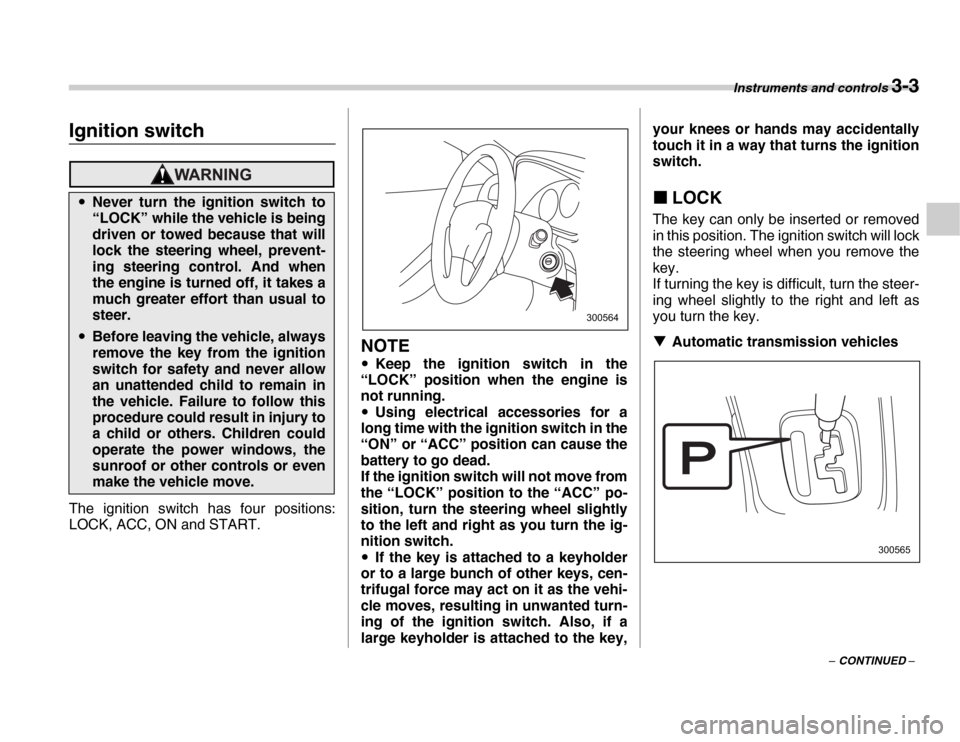
Instruments and controls 3-3
– CONTINUED –
Instrume nts an d c ontrolsIgnition switch
The ignition switch has four positions:
LOCK, ACC, ON and START.
NOTE
�y Keep the ignition switch in the
“LOCK” position when the engine is
not running. �y Using electrical accessories for a
long time with the ignition switch in the
“ON” or “ACC” position can cause the
battery to go dead.
If the ignition switch will not move from
the “LOCK” position to the “ACC” po-
sition, turn the steering wheel slightly
to the left and right as you turn the ig-
nition switch. �y If the key is attached to a keyholder
or to a large bunch of other keys, cen-
trifugal force may act on it as the vehi-
cle moves, resulting in unwanted turn-
ing of the ignition switch. Also, if a
large keyholder is attached to the key, your knees or hands may accidentally
touch it in a way that turns the ignition
switch. �„
LOCK
The key can only be inserted or removed
in this position. The ignition switch will lock
the steering wheel when you remove the
key.
If turning the key is difficult, turn the steer-
ing wheel slightly to the right and left as
you turn the key. �T Automatic transmission vehicles
�yNever turn the ignition switch to
“LOCK” while the vehicle is being
driven or towed because that will
lock the steering wheel, prevent-
ing steering control. And when
the engine is turned off, it takes a
much greater effort than usual to
steer.
�yBefore leaving the vehicle, always
remove the key from the ignition
switch for safety and never allow
an unattended child to remain in
the vehicle. Failure to follow this
procedure could result in injury to
a child or others. Children could
operate the power windows, the
sunroof or other controls or even
make the vehicle move.
300564
300565